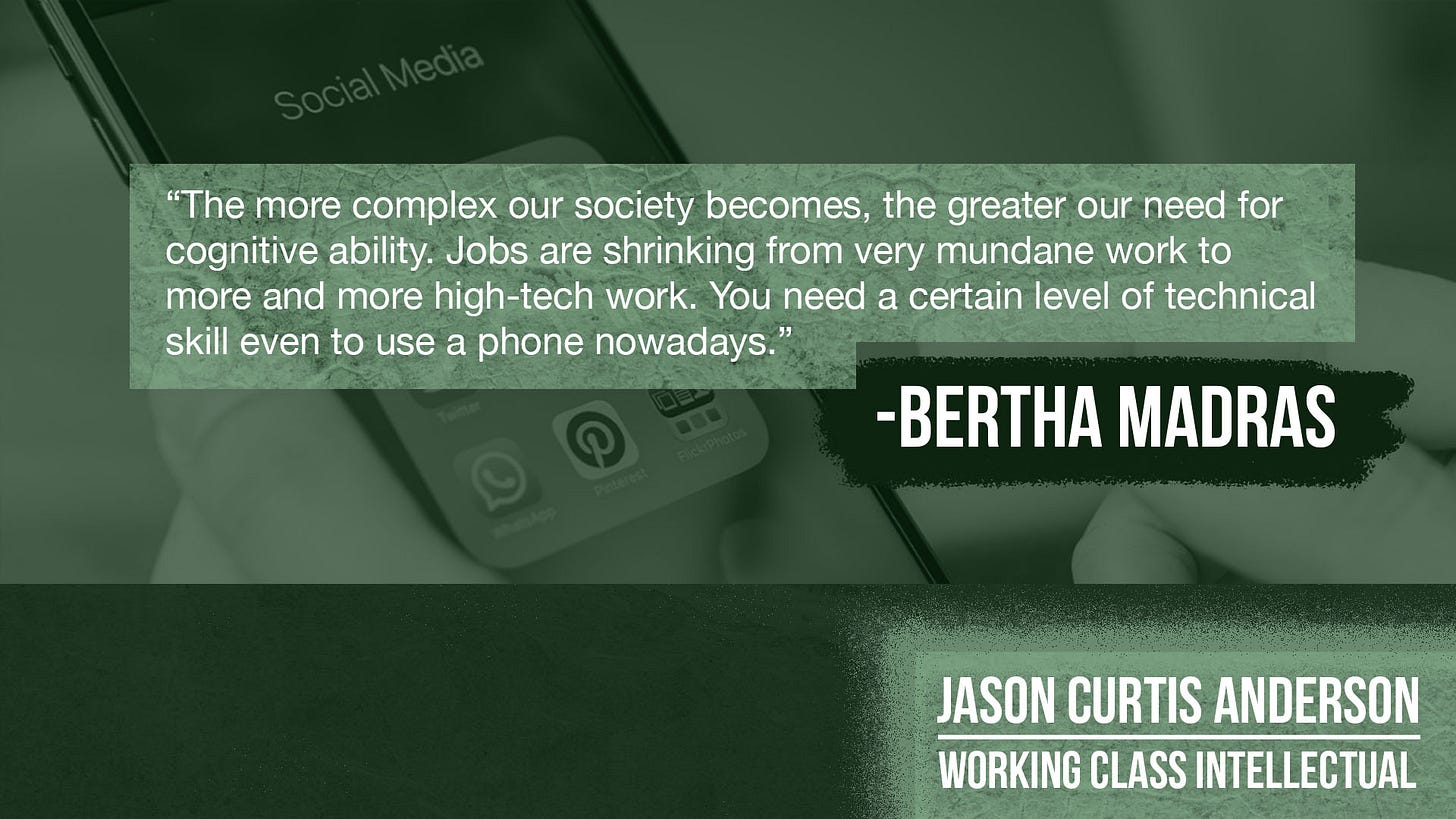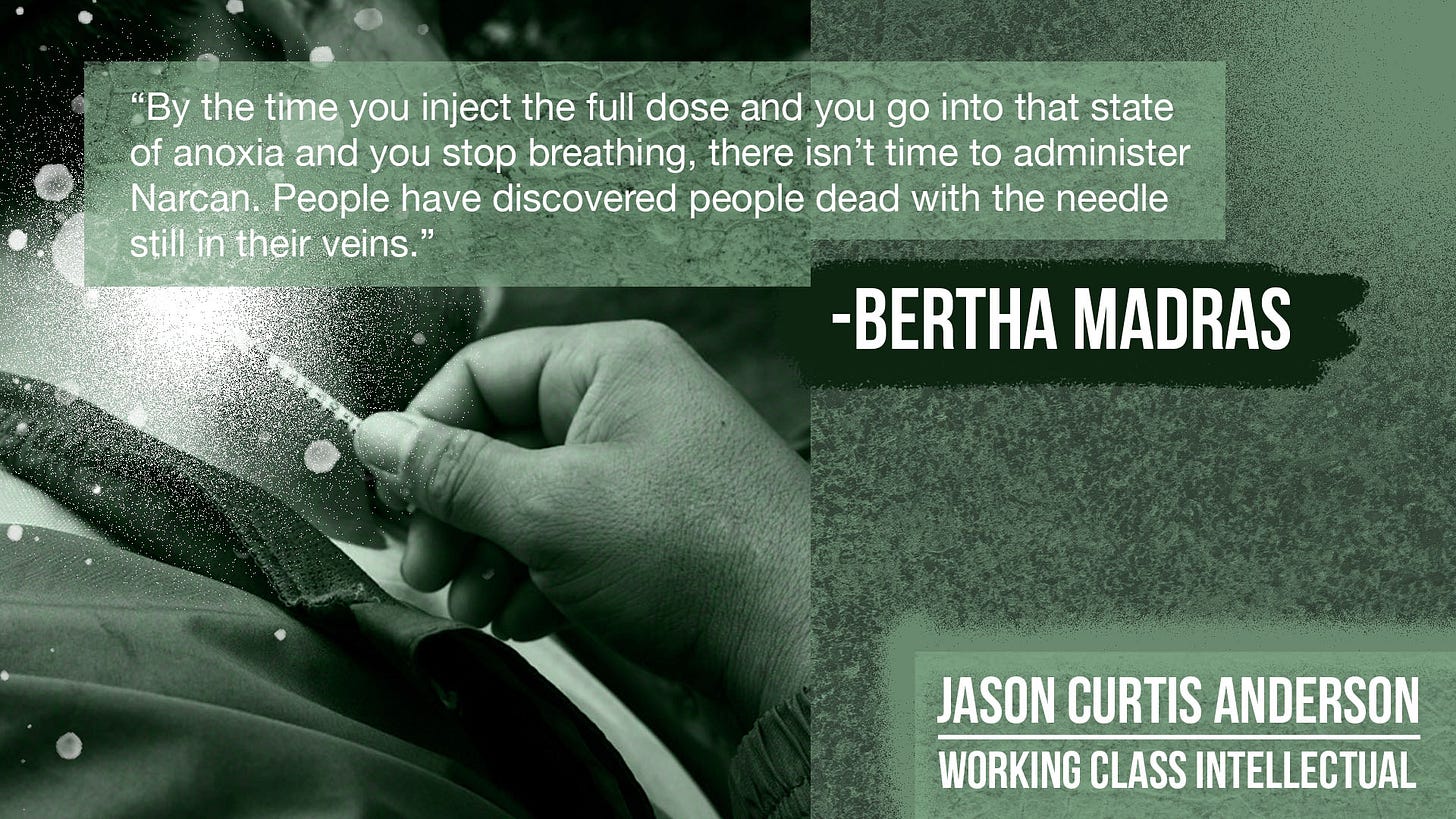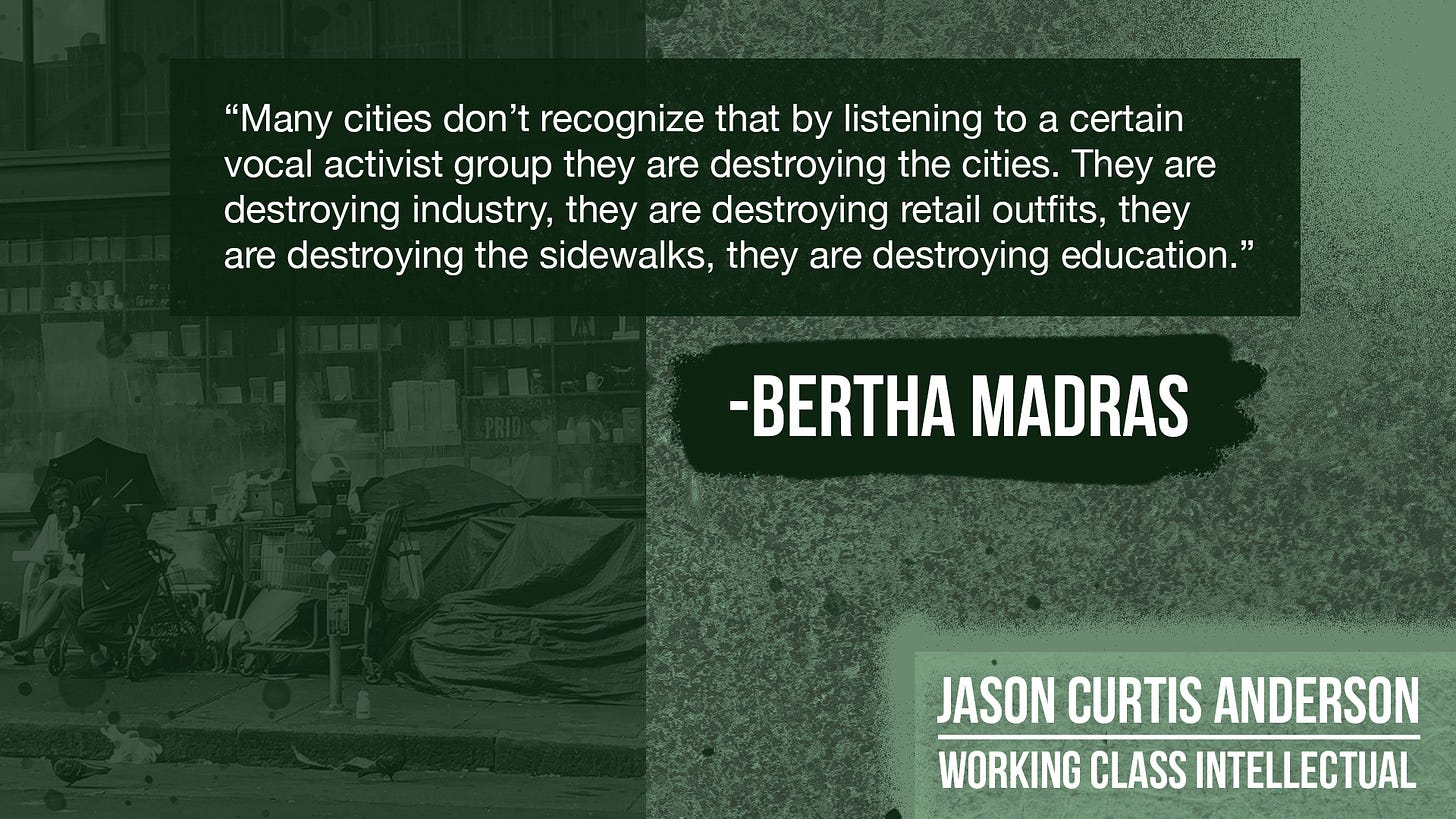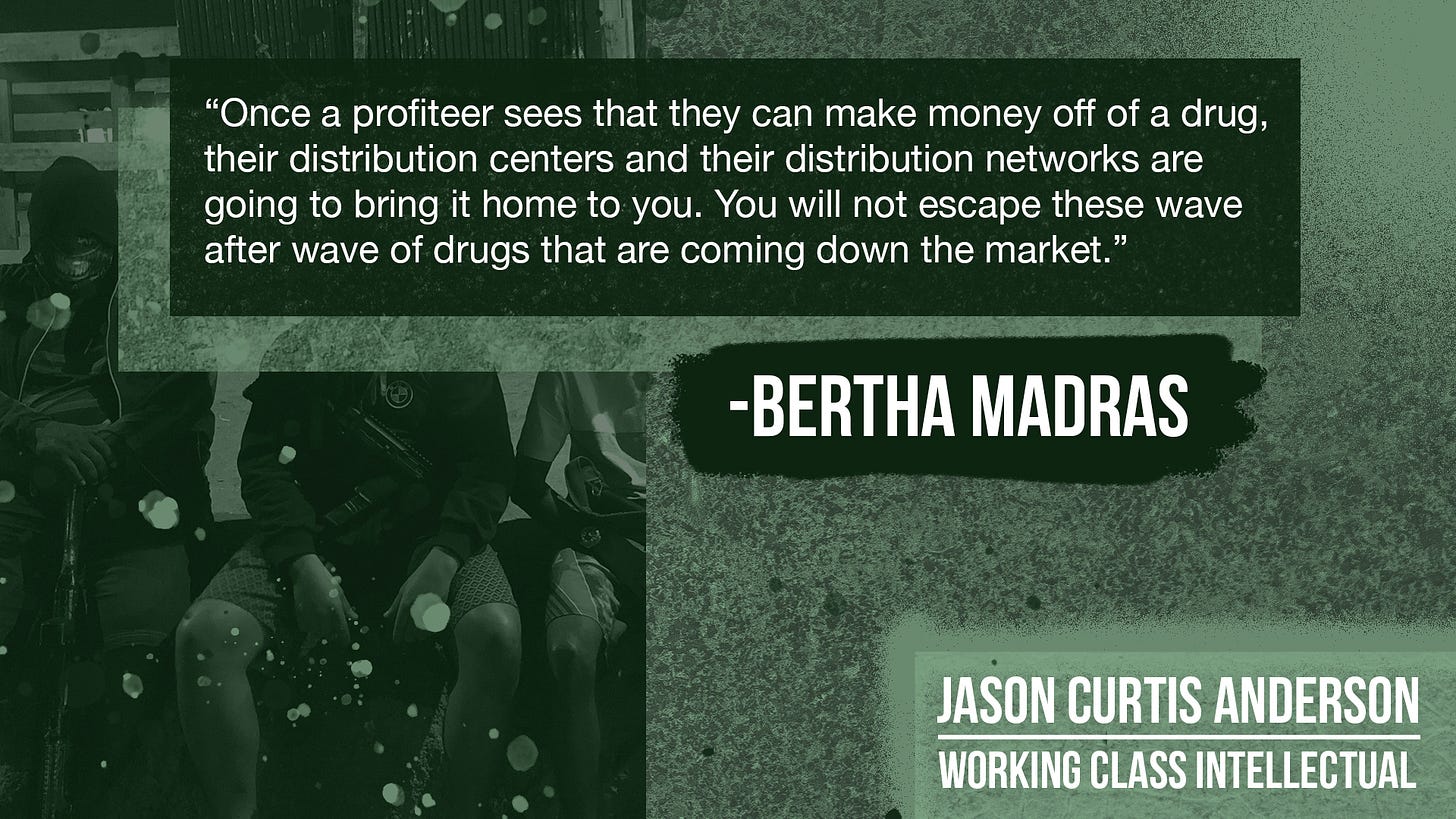Meet Bertha Madras - Part 1
One of America's foremost experts on how drugs affect the human brain sits down with Jason Curtis Anderson to discuss the Fentanyl crisis, drug legalization, and the future of American cities.
I recently sat down with Dr. Bertha Madras to talk about America's (and NYC’s) drug crisis. Bertha is a professor of psychobiology in the Department of Psychiatry at Harvard Medical School who has been working in the field of drugs for many years. She was the Deputy Drug Czar of the United States under the Bush 43 Administration and was also recruited to the President’s Opioid Commission in 2017 to help come up with solutions to combat opioid addiction. All of this important policy-related work occurred in the gaps outside of her real job, which is to investigate how drugs affect the human brain.
Jason: Thank you so much for joining me! I tried my best to tailor this conversation so you could unpack your drug expertise in a way that only you can, but also to help the people of NYC understand these things better, as well as the politicians that are enabling and encouraging the current drug crisis. I want to provide some support to parents who have teens that might encounter drugs, and to really inform everyone within my reach. NYC is at a crossroads where we are seeing drug addiction in the streets, on the subways, and even in the classroom. Let’s get into the first question!
Jason: America has really warmed up to legalizing marijuana in recent years and now we’re seeing an explosion of smoke shops in NYC. 1,450 shops have opened up in the last few years. How worried are you about the normalization of marijuana usage and the evolution of THC levels rising from 4% to 40%+ and up to 90% in THC oils?
Bertha: In a word, extremely worried. Reason one is once you normalize use and open up shops everywhere, any effort to keep this away from young people is a waste of time. Also, if parents are using, and the kids have access, then the kids are using, and we have very good data on that. Reason two is that the potency problems are real, they are unregulated, and they are deliberately unregulated. So you ask: what is the problem with increased potency? We are just beginning to get the studies now, there are only 7 or 8 studies so far, but there should be 50 to really solidify the data on it, but we do have enough data on it to make the following statements that are actual:
There is a more rapid progression to addiction to marijuana (cannabis use disorder) that comes with greater potency. There are more people among adolescence that have cannabis use disorder if they use highly potent marijuana. There are more psychotic disorders. This is a very robust finding because increased psychotic disorders really narrow it down to psychosis. And why would I worry about psychosis? I’m worried about it because people who react to marijuana by developing psychosis have a higher probability of progressing to developing schizophrenia which is essentially a lifelong disorder of the brain. In order to remain stable one has to be on medication for life.
Some people are more compromised than others but this is a major mental illness. There’s also excellent data that the higher the potency there’s more memory impairment, more social problems with friends and family, more emergency care needs, and even overdoses.
Marijuana is the most self-delusional drug we have. Most people who drink too much recognize it, most people who use opioids or cocaine recognize that something is wrong in their lives. Marijuana is a self-delusional drug that almost lulls you into feeling better and that there’s nothing wrong. There’s even something called cannabis-hyperemesis syndrome which means uncontrollable vomiting. Marijuana is the most self-delusional drug we have. People who get diagnosed with cannabis-hyperemesis syndrome will not even accept a medical diagnosis that states this is due to marijuana. They think there is something wrong with their stomach and it has nothing to do with the drug. Yet, if you stop the drug, the vomiting stops. Period.
Jason: Do you think we are dooming a generation of young people to have mental health issues later in life by encouraging and enabling drug use?
Bertha: Yes. There are very good studies that show that people who start using marijuana and don’t stop, and continue to use, end up later in life with very specific problems. One of which is a lower IQ, and unfortunately the more complex our society becomes, the greater our need for cognitive ability. Jobs are shrinking from very mundane work to more and more high-tech work. You need a certain level of technical skill even to use a phone nowadays. People who continue to use are also at higher risk for psychosis, and at higher risk for having substance use disorders later on. Not only for marijuana but for alcohol, but smoking and others as well, including opioids. They are also at risk as well for having social problems. Not having a stable social setup for themselves that will reinforce good habits and good values which means having a job, having housing, having stability in one’s life.
If you actually look at some of these longitudinal studies, what you see is that the more you use during youth, If you’ve used more than 400 times there’s a dose response that the more you use, the more likely you’ll be homeless, unemployed, on welfare, the much less likely you will graduate from college, or even drop out of high school before you even contemplate going to college. It’s a very unpretty picture for people who continue to use.
Jason: People all over the country are dying because they took fentanyl unknowingly. There are plenty of stories about college kids taking a pill that they think is Xanax (or something that they have taken before) and not knowing that they just took a fatal dosage of Fentanyl. Do you think the country is having an honest conversation about Fentanyl being a poison, and how often it’s being found in drugs that people never agreed to take?
Bertha: That’s an excellent question. I think it is both a poison and just the newest dangerous drug. Clearly, a poison because people are dying. One of my friends is a neuroscientist and has a husband who is also in this domain. They sent their child off to college in California, never having touched drugs. The senior class had invited the freshman class to a party in their dorm, and the purpose of the party was to introduce them to drugs. The child took marijuana for the first time in their lives, they got out of control. The college ended up having a hearing on the fate of this child for saying unpleasant things to others while under the influence. He was so nervous, someone handed him a pill and told him it was something to help him sleep. He was later found dead in his dorm. The universities have federal regulations that govern substance use on campuses, they are not at all regulating it. It’s a disaster.
The number of people who apparently don’t know it’s fentanyl, varies. It’s very hard to know the data. I’ve seen data that say 25% are unaware, some say higher.
We just don’t know how many are aware or not aware. The problem is that fentanyl is so potent that if you are not accustomed to it, a very low dose can kill you, and it can kill you instantly. Tolerant people who have used it for a long time are much more accustomed to the effects. By the time you inject the full dose and you go into that state of anoxia and you stop breathing, there isn’t time to administer Narcan. People have discovered people dead with the needle still in their veins because they were in the midst of injecting. The other thing about fentanyl that’s so hazardous is that because it’s so potent in such tiny amounts, being able to distribute it evenly among fillers, if you’re not an experienced compounder so to speak, it’s very hard to distribute it. You’re just playing Russian roulette with your life.
Jason: Drug recovery advocate Tom Wolf claims that getting arrested saved his life. Do you think we are failing to protect a generation of young people by cities giving up on enforcing drug laws?
Bertha: We are failing young people in multiple ways. There is complete complacency. I know the DEA does its best, but it does not have the backing of the powers that be. It is still considered almost a pejorative term to say that you work for the DEA, yet their mission in life is to save people from becoming addicted, dying, becoming homeless, and losing their jobs, their families, and their educations. That’s what it’s all about, the so-called failed war on drugs. It’s only failed because we have failed to exercise resolve.
But we’re failing not only that way, we’re failing because we’re not educating our young people about the hazards of drugs. The media is part of the problem, they are promoting it, the latest of course is hallucinogens. They promote the glamour, the fact that it’s new, it’s interesting. Young people are getting to the point where they think that drug use is a normal part of life, it’s a right of passage, it is something that is part of the ritual of just being. That is absolutely a false premise that nobody has had the courage at the federal government to get up and say “Just don’t use drugs because they can absolutely affect the course of your life.”
Jason: For years there has been a narrative in the media about the failures of the drug war. But it is my personal belief that we need to abandon that conversation and start a much more important one. One that acknowledges that we are currently surrendering public space in our cities, as well as the well-being of an entire generation of young people to Fentanyl which is significantly more lethal than every other drug, including heroin. How do you see this issue?
Bertha: Well, the Fentanyl data, there is just a tiny breath of fresh air in terms of the turnaround. I see this as more of a drug issue per se than a fentanyl issue only. Fentanyl is the worst, it is the most horrible because it causes such a high rate of lethality, so we have to recognize that. But I think that many cities don’t recognize that by listening to a certain vocal activist group they are destroying the cities. They are destroying industry, they are destroying retail outfits, they are destroying the sidewalks, they are destroying education.
Why would you live in San Francisco now? Why? The entire city, the subways are plagued with criminality, the streets have tent cities, it is unsafe to park your car anywhere, the office spaces are now about 30% unoccupied. Major retailers are leaving, all of this is a consequence of this policy because drugs affect everything else.
Above all, they affect human behavior and they affect it adversely. If one is in the mode of using and you lose your housing, lose your job, lose your college education, moving onto the street is simple. Once on the street, there’s a great deal of lawlessness that abounds. And once it abounds, the boundaries get more and more eroded until it becomes detritus, until it becomes a cloaca, just a black hole of nothingness and that’s what’s happening. I think Portland, Denver, parts of Austin, parts of LA, and parts of Philadelphia are just dramatically deteriorating because of permissiveness to this lifestyle.
Jason: People in NYC aren’t familiar with the P2P meth crisis that’s taking place in west coast cities. Are there any insights you could share with them about what you see?
Bertha: The first thing I would say to New Yorkers is never think because something is 3,500 miles away that it isn’t coming to you. Fentanyl was an east coast problem. It was east of the Mississippi, and part of the reason was that the heroin that was used to disguise the fentanyl was white. Fentanyl crystals are purified, they turn out to be white, and it’s very easy to disguise it. In the west, most of the heroin was more dirty, more impure, a little bit yellow, contaminants were easier to see. And the people producing it never really had the motivation to cross the Mississippi until the profits became so obvious. Pure fentanyl was transported to the west coast. California did not have so much of an overdose problem as the major cities in the east, and now it’s one of the epicenters of the world in terms of overdoses. If any NYer thinks we are secure from methamphetamine, xylazine, fentanyl-hybrids, or anything, don’t ever think that.
Once a profiteer sees that they can make money off of a drug, their distribution centers and their distribution networks are going to bring it home to you. You will not escape these wave after wave of drugs that are coming down the market.
Jason: NYC is planning to open up several more safe injection sites in the near future. What do you predict will happen to NYC if we continue down this path?
Bertha: Well, it’s part of this whole harm reduction issue and I know that there is an increasing embrace of harm reduction as a solution to the crisis. There is a problem with the whole harm reduction movement. The problem is that it is a term that has become undefined. Safe injection sites are now considered harm reduction, a decade ago, harm reduction was to give out clean needles and to distribute naloxone and buprenorphine to treat an opioid use disorder. Now we are moving into another phase of harm reduction which is to have places where you can inject drugs, supervised injection sites, and safe supply, both of those. And also handing out free paraphernalia to users. There is no limit and there is no boundary in harm reduction, that is the first principle I think we have to recognize. As soon as you satisfy one format for harm reduction, it will go on to the next, and to the next, into areas that some people would consider outrageous like safe supply. Vancouver has automatic dispensers of hydrocodone.
So, what has happened with supervised injection sites? Vancouver was one of the pioneers, and I believe another place in Australia. Not only has the overdose death rate not declined, it’s just soared. And why has it soared? It’s soared because Fentanyl keeps coming into the system, the people who use these supervised injection sites are not identified. So you don’t know if they used one day here, and they are rescued so you have the data, “Wow it’s working, we are rescuing that person!” and the next day they are going to use on the streets. And around these supervised injection sites are dealers. There is nothing better for a dealer than to have a centralized marketplace.
The other problem with them is that I’ve looked at the data, how many people actually get into treatment from this opportunistic moment where you need a nurse, you need a healthcare professional, you need a recovery coach. The numbers are very low.
Jason: NYC has refused to release their numbers.
Bertha: That makes sense because I’m sure they are probably 3-5% if that much. I’m not sure what they are, these are the numbers I’ve been told by word of mouth. What is the point of having a place where you meet a person where they are and leave them where they are? That’s the problem. We are leaving them exactly the way they came in, instead of saying here is a wonderful opportunity to gradually, step-by-step, begin to give them a sense of what can be in their lives and how much better it could be. And instead of using that opportunity (because most people use alone). People who die are using alone, there is no contact with professionals. Here is this wonderful opportunity for contact, but it’s not being exploited. Because it is being managed by people who actually don’t want drug use to end. That’s the problem.
Jason: The safe injection site in Harlem has expanded its offering to include a host of ridiculous non-related things. They’ve got massage now, they’ve got laundry service, food, and a relaxation lounge. To me, they use it as a cover to distract from what they’re really doing. Because now when you say “We’ve gotta shut this place down, it’s destroying the neighborhood, it’s destroying local businesses, children have to walk by drug addicts in the street, there are syringes all over the streets.” now they respond “Oh what, you don’t want homeless people to have clean laundry? You’re a monster!”
Bertha: What I feel is that every possible way to shape and carve the narrative to suit the ultimate goal which is enabling drug use, and enabling ongoing drug use is being used. And the campaigns are brilliant in terms of their strategies, they outfox a lot of people of goodwill because they use strategies that seem to be so common sense but they are in fact the antithesis of common sense.









